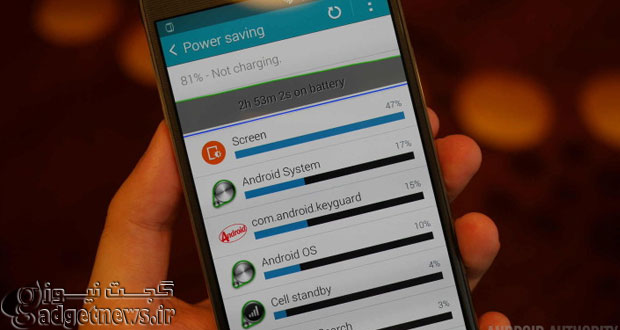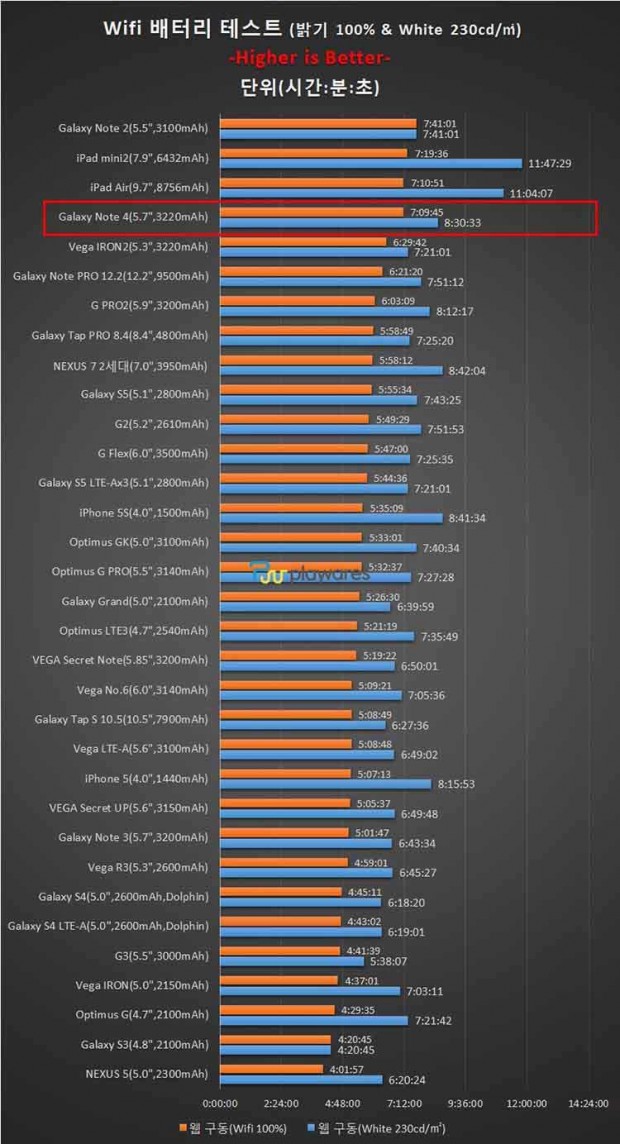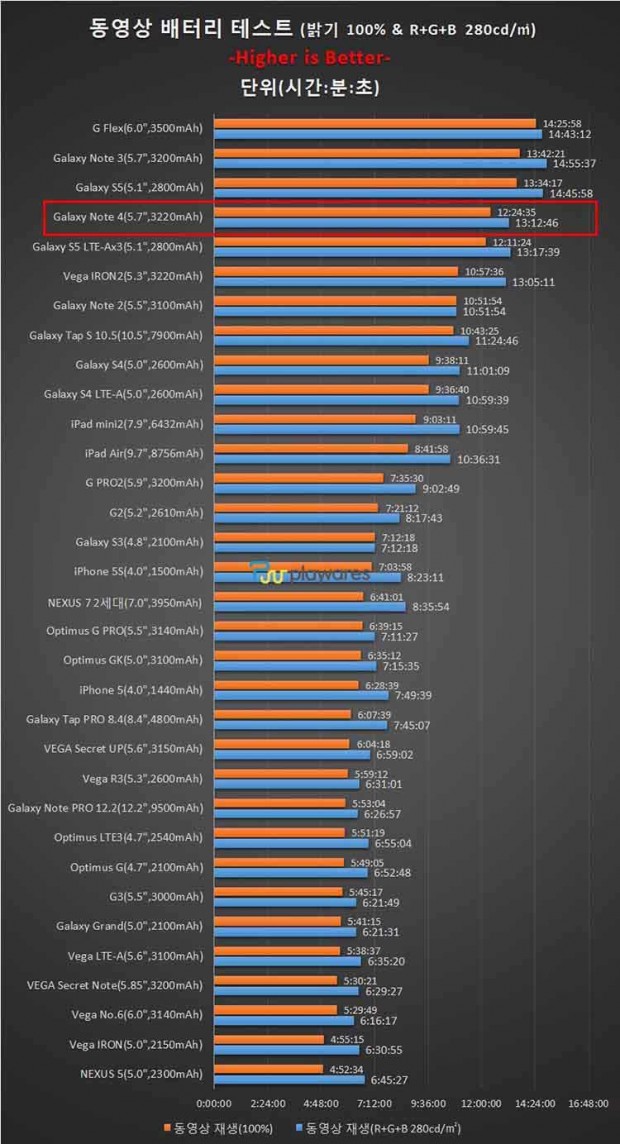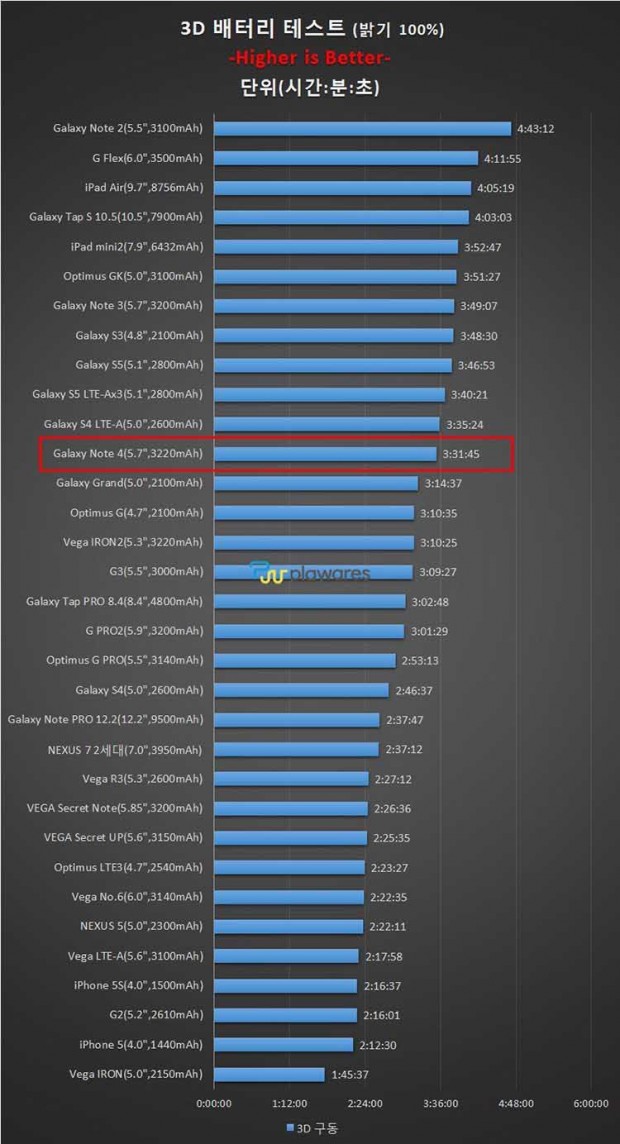سامسونگ گلکسی نوت 4 بالاخره از راه رسیده و حالا وقت آن است که به مرور شاهد انجام تستهای مختلف بر روی یکی از برترین فبلت های تاریخ اسمارت فون باشیم. اخیرا وبسایت کره ای PlayWare تستهای مختلف عمر باتری را بر روی ورژن کره ای این اسمارت فون با نخستین پردازنده 64 بیتی اگزینوس 5433 سامسونگ اجرا کرده است.
این تستها شامل حداکثر زمان روشن ماندن صفحه نمایش در میزان خاصی از درخشندگی، استفاده از وای فای، پخش ویدیو و بازی سه بعدی میشود. با هم نگاهی به نتایج به دست آمده از این تستها میاندازیم.
گلکسی نوت چهار توانسته همزمان با پخش یک تصویر کاملا سفید طول عمری هشت ساعت و 30 دقیقه ای را به نام خود ثبت کند که به مراتب بالاتر از الجی G3 با زمان پنج ساعت و 38 دقیقه میباشد. شاید یکی از مهمترین دلایل این عمر بالاتر به واسطه صفحه نمایش AMOLED به کار گرفته شده در گلکسی نوت چهار باشد.
نکته تعجب برانگیز این تست طول عمر بیشتری گلکسی نوت چهار در این تست نسبت به گلکسی S5 LTE-A با یک رزولوشن پایین تر است. چنین اتفاقی بدون شک به دلیل وجود اگزینوس 5433 با هستههای کرتکس A53 و پردازنده گرافیکی Mali-T760 اتفاق افتاده است. بنابراین حداقل در این تست ثابت شده که اسنپ دراگون 805 با هستههای Krait 450 و پردازنده گرافیکی آدرنو 420 مصرف بالاتری در میزان انرژی دارد.
وقتی میزان مصرف انرژی در حالت استفاده مداوم از وای فای را نیز بررسی کنیم، باز هم گلکسی نوت چهار از تمامی پرچمداران با ثبت رکورد بیش از 7 ساعت طول عمر بیشتری را ثبت کرده است.
در تست پخش ویدیو اما طول عمر گلکسی نوت چهار و گلکسی S5 در اندازه ای برابر، طول عمری 12 ساعتی را ثبت کردهاند که نشان از عدم تأثیر پردازندهها در میزان بهینه تر مصرف انرژی دارد. در عوض هنگامی که گلکسی نوت چهار و S5 را با دیگر اسمارت فون های LCD دار چون G3 و نکسوس پنج مقایسه کنیم، به وضوح طول عمر بیشتری برای AMOLED داران ثبت شده است.
در نهایت به تست بازیهای سه بعدی میرسیم که گلکسی نوت چهار طول عمری حداکثر 3 ساعت و 30 دقیقه ای را داشته است. طبیعتا در این اسمارت فون به دلیل صفحه نمایش QHD و بالطبع افزایش نیاز به پردازنده گرافیکی برای رندر پیکسلهای اضافی نتیجه ای جز مصرف بالای انرژی را نتیجه نمیدهد. اما با این حال گلکسی نوت چهار با اگزینوس 5433 خود باز هم در میان دستگاههای جدید تست شده بهترین نتیجه را به نام خود ثبت کرده است. باید دید نسخه اسنپ دراگون 805 این اسمارت فون تا چه میزان در برابر ورژن اگزینوس مقاومت از خود نشان خواهد داد.
گلکسی نوت 4 چه در قدرت سخت افزاری و چه در میزان مصرف باتری رکورددار بازار است و بدون شک سامسونگ در سال آینده با بهبود تکنولوژی AMOLED و همچنین بهینه سازی چیپست های اگزینوس خود حرفهای بسیاری در بازار برای گفتن خواهد داشت. به نظر آینده خوبی حداقل در حوزه تولید چیپست در انتظار سامسونگ خواهد بود.
منبع : androidauthority
Exynos Galaxy Note 4 outlasts the competition in battery tests
Exynos Galaxy Note 4 outlasts the competition in battery tests
The Samsung Galaxy Note 4 is finally here, boasting some of the best hardware on the market right now. However, higher resolution displays and faster processors all require more battery life, the one are that smartphones are struggling to improve.
One of the handset’s intriguing features is the addition of Samsung’s first 64-bit Exynos processor, which can be found in the Korean version. Although the processor is running in AArch32 (32-bit) mode, it still makes use of ARM’s latest powerhouse Cortex-A57 and battery friendly A53 CPU cores in a 4-by-4 big.LITTLE configuration. Big.LITTLE is ARM’s method of arranging CPU cores for the optimal balance of performance and battery life.
Thanks to extensive testing carried out by Korean site PlayWare, we can take an early look at just how energy efficient the Note 4 and this SoC are. The short answer – very.
Testing time
The Exynos version Galaxy Note 4 has been put through a wide range of battery tests, including peak display brightness calibration, WiFi and screen on-time, video playback, and 3D gaming. To keep the comparison fair across the range of devices tested, the brightness level has been set to consistent 230 nits.
Without further delay, here are the results (Wifi, video, then 3D gaming):
The Galaxy Note 4 manages a decent 8:30 hours with its display constantly on with a pure white image, which, considering the high display resolution, is much better than the LG G3’s 5:38. Although we could probably put some of this down to Samsung’s AMOLED display technology too.
Impressively, the Galaxy Note 4 manages a higher screen-on time than the lower-resolution Galaxy S5 LTE-A, suggesting that the Exynos 5433’s Cortex A53’s and Mali-T760 have a lower idle battery drain than the Snapdragon 805’s Krait 450 CPU cores and Adreno 420 GPU. When it comes to WiFi-on time, the Galaxy Note 4 is also the best of the current flagship devices. Managing just over 7 hours of constant use.
The video playback test also shows a mighty performance for the Galaxy Note 4 and Samsung’s Galaxy S5, both scoring well over 12 hours each. This suggests that the CPU is having less of an impact on the energy savings made here. Instead, when we compare results with those handsets with similar hardware, such as the LG G3 or Nexus 5, we can conclude that the AMOLED display is responsible for most of the power savings, along with efficient digital signal processing.
Finally, the big test of energy efficiency is 3D gaming. Here we can see less of an advantage for the Note 4 at just 3:30 hours, although it still performs very well. Due to the Note 4’s QHD display, the GPU is working extra hard to render those extra pixels. Additional strain equates to more energy consumption. Overall though, the Exynos Note 4 is still the best performer out of the tested devices. I’d really like to see exactly how it stacks up against the Snapdragon version.
Limited availability
Although most of us won’t be able to get our hands on the Exynos 5433 powered Galaxy Note 4 and enjoy all these power saving advantages, there is some good news to be taken away from this for Western consumers. Next year’s Snapdragon 808 and 810 processors will also be making use of the same Cortex-A57/A53 CPU configuration as the current Exynos 5433, and will likely end up in a number of high-end devices next year. MediaTek’s MT67XX and Qualcomm’s Snapdragon 610 and 615 are also be making use of the energy efficient Cortex-A53 core for mid-range devices.
Samsung’s Galaxy Note 4 is clearly leading the field at the moment, both in terms of hardware power and battery longevity. Although Samsung will retain its AMOLED technology, next year’s flagship smartphones will all likely use SoCs with higher levels of performance and improved battery efficiency. There is plenty to look forward to.
 گجت نیوز آخرین اخبار تکنولوژی، علم و خودرو
گجت نیوز آخرین اخبار تکنولوژی، علم و خودرو 









